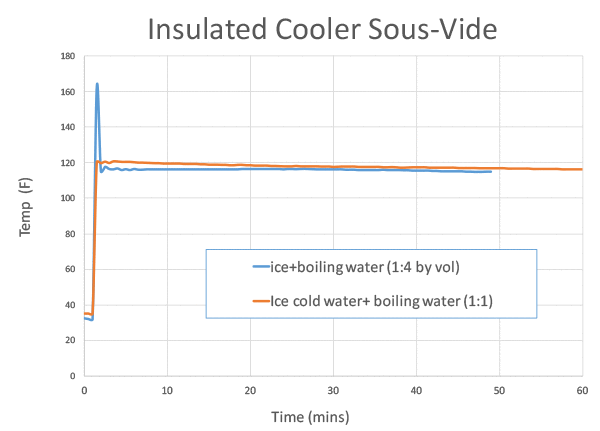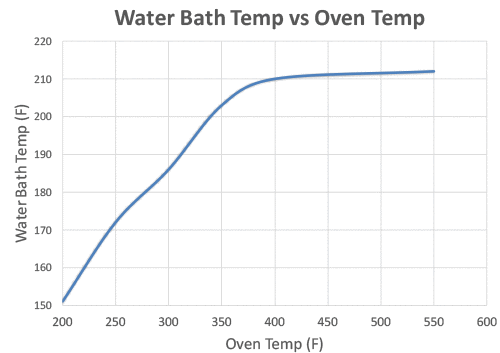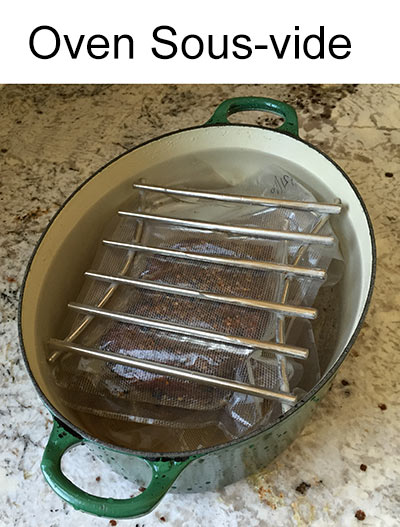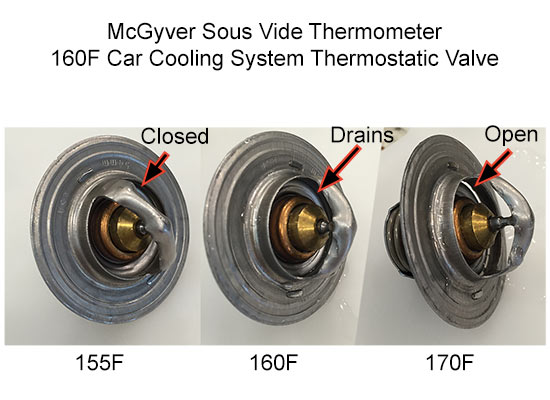| g e n u i n e i d e a s | ||||||
 |
 |
 |
 |
 |
 |
 |
| home | art and science |
writings | biography | food | inventions | search |
| sorta sous-vide |
| Aug 2016 |
|
Every once in a while a new cooking method comes along, bright with promise, only to fade as people realize it is too complex or expensive or ineffective. Microwave ovens promised to revolutionize home cooking, but now are mostly relegated to reheat food and pop corn in paper bags. Combi ovens (heat and humidity) are standard in restaurant kitchens, but way too fussy for harried home cooks to master. So they are nearly absent in American homes. And then there is sous-vide, the darling cooking method for the ever-trendy molecular gastronomy movement. Precise, unfamiliar, and wrapped in mystery. Is there any way to try before you buy a sous-vide machine? Sous-vide translates literally as "under vacuum", and is named for the vacuum bags that typically hold ingredients free of contamination. The same vacuum bag minimizes insulating air pockets and bubbles, assuring the food is in tight thermal contact with any exterior heat source. But the real magic is the heat incubator, which is adapted from the temperature controlled water baths found in most chemistry labs. An electric immersion element heats a tub of water, a pump circulates the water so all nooks and crannies of the container are at the same temperature, the food bag soaks in the hot tub, while a fancy electronic control system measures the temperature and cleverly adjusts the heating current to hold within a few tenths of a degree for as long as required. A few tenths of a degree? Can this really matter in cooking, when most kitchen ovens vary by 25F as they cycle on and off to maintain the dial setting? Well, it does matter when gently cooking an egg or an emulsion. A degree here or there is the difference between a runny yolk and a thick gooey mess, or a broken sauce. But for most recipes, 5F control over the water bath is more than good enough. Hell, even sometimes 10F. Which opens up a world of low cost, flexible alternatives to a commercial sous-vide system. There are three different approaches to improvising a sous-vide bath. These three methods are personified by three fictional characters. Consider the simple act of fishing, using nothing more than parts scavenged from a junk yard (or from some backyards).
Now, each approach has its own merits, place and time. Not to mention legal implications. I lean towards the McGyver end of the scale, but let's give all three techniques a shot at improvised sous-vide. Reverse Sear Sous-vide
Conveniently, the picnic is held near a junkyard, and the food is brought to the fire in an ice-filled cooler. The Martian would scrounge up an old aquarium as a bath. A car water pump for circulation. A battery for power. Attach a radiator to the grill and another to the aquarium, running hot water between the two. And rig up a control circuit from an old bi-metal thermostat to power a solenoid water valve. Whew, hard work. Good thing he had the time available while stranded on Mars. McGyver chooses a simpler solution. Fill the cooler half way up with ice cold water (NO floating ice cubes, just water that has been soaking in ice for a while). Place the ice cold vaccu-bagged steak in the water. Then, add an equal VOLUME of boiling hot water from a pot on the grill. The two will mix (see orange curve below) and almost immediately average out to a perfect 120F. Let the steak (or burger or chicken) simmer for an hour or two, then finish on the grill. Alternatively, you can put the steak under ice that has been in water (so the ice is at 32F, rather than 0F right out of the freezer), but no ice water. Around 1 part ice cubes1 to 4 parts boiling water, by volume. The temp (blue curve) overshoots for a minute til the ice melts, then settles in at 120F. And don't sweat the details. If the water ends up at 115F, just grill a bit longer. With a bit of practice (and a Sharpie to mark water levels inside the cooler), you'll find the perfect ratio of liquids, and amaze your friends by turning out juicy steaks on demand.
How about the redneck version? Well, the old Lincoln Continental's back seat is black leather cracked from sitting in the yard for three decades. On blocks. In the sun, the leather gets up to 120F. More or less a redneck solar oven. Just lay the vacuu-bagged steak on the seat, wait a couple of hours, and grill.
Sous-vide Brisket Sometimes you need to sous-vide for almost 24 hours at temperatures closer to 160F than 120F. Especially for a big, tough cut of meat. For example, our friends at Chef Steps posted a great guide to sous-vide short ribs, and Serious Eats published one for chuck. They both controlled the water bath with table-top immersion heaters. Nice if you own one, overkill if you don't. But we have a simpler, cheaper way... The Martian simply grabs his aquarium rig, and readjusts the temperature control circuit to 160F. Which illustrates the advantage of doing things right the first time. At home he might put the radiator on the stove top for heat, instead of the grill. Or replace the radiator with an electric heating element pulled from a coffee pot, and connect the thermostat to a relay to the coffee pot cord. Either way, running for a day is no problem. McGyver knows his science, and realizes water, even in a standard home oven, cools by evaporation. Amazingly, a pan of water in a 300F oven won't boil, it simmers at 185F (higher or lower depending on how well sealed your oven is, whether it has a convection fan, etc. but the graph is a good first estimate).
So McGyver scrounges a deep container (a lobster pot or dutch oven is best), fills with hot tap water, drops in the vaccu-sealed meat, and uses a heavy grate to hold the bag below the water's surface2. I aimed for 165F to cook this pastrami flat, and in our new oven which is really well sealed3, set the temperature dial to 190F. After two hours, the water bath settled in at 165F. I topped off the bath a few times, but it ran without trouble for over a day:
If you cover the pot, or allow a layer of oil to float to the surface, evaporation is suppressed, and the water will boil! Now, how would McGyver measure the temperature? Frankly, if you want to try this simple technique at home, buy a good cabled digital thermometer and stick it in the water. But McGyver knows many automobile cooling systems are controlled via a "wax thermostat". He goes to the junkyard, finds one marked at "160F", and dunks it in the sous-vide bath. The valve is quite accurate, opening slightly at 160F (water will drain from the cavity if the valve is lifted from the bath), and visibly triggered at 170F. So he adjusts the oven temp by referencing the thermostat's valve position:
And the redneck solution? Well, there is always Uncle Fred's copper still out back. Moonshine condenses at around 170F. Simply float the vaccu-bag of brisket in the hootch. If the smoky brisket flavor mixes in, you can always sell it at a higher price, as hill country bourbon...
|
|
-------------------------------------------------------------------------------------------------------- Additional articles on kitchen science can be found HERE. 1 Why does the temperature end up at 120F? When boiling water (212F) and ice water (32F) are mixed 50:50, the temperature averages to (212F+32F)/2=122F. With ice, some of the boiling water first has to melt the ice into a cold liquid, and then the cold liquid averages with the hot water. This melting energy is the latent heat of fusion, and is around 333J/cc. Boiling water's embedded energy can be estimated from its heat capacity (around 4.2 J/cc). To melt one cc of ice, boiling water drops by (333/4.2=80C, or down to 20C=70F). And then this colder water averages with the now 32F=0C ice water. So just a little bit of ice goes a long way toward cooling off the boiling water. A bucket of ice is about 1/3rd air. So doing a bit of math, it turns out one part ice (no water) to four parts boiling water is about right. With a bit of windage to heat up the cooler's walls. Make sure the water is at a full boil-- just simmering could be 5F lower in temperature. Meat is almost 70% water, so for the purposes of the cooler chest method, meat acts like an additional amount of cold liquid. Again, don't seek perfection, but with a bit of trial and error, you can find a ratio that works in your brand cooler. Of course, at home you can simply run tap water til it reaches 120F, then fill the cooler. But where's the fun in that? 2 When the water bath is at 165F, the oven's air temp might be much hotter, and could melt edges of the plastic bag that poke up above the water's surface. Make sure the bag is always submerged. A well sealed oven reaches much higher humidity than an oven with a warped, leaky door. More humidity slows evaporation, so the water bath cools less efficiently, and simmers at a higher temperature. Variations in oven humidity (and temperature uniformity) are a major reason why recipes don't always turn out the way they look in the book.. |
 Contact Greg Blonder by email here - Modified Genuine Ideas, LLC. |
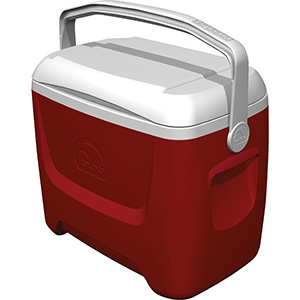 The best way to grill a steak or a thick burger or a chicken breast is to pre-heat the meat to a few degrees below "done", then quickly grill before serving. The meat is tender, uniform, develops a flavorful crust, and is much harder to overcook than the typical flaming bonfire on the barbie. The motivation to pre-heat are discussed widely on-line (and in my article
The best way to grill a steak or a thick burger or a chicken breast is to pre-heat the meat to a few degrees below "done", then quickly grill before serving. The meat is tender, uniform, develops a flavorful crust, and is much harder to overcook than the typical flaming bonfire on the barbie. The motivation to pre-heat are discussed widely on-line (and in my article 